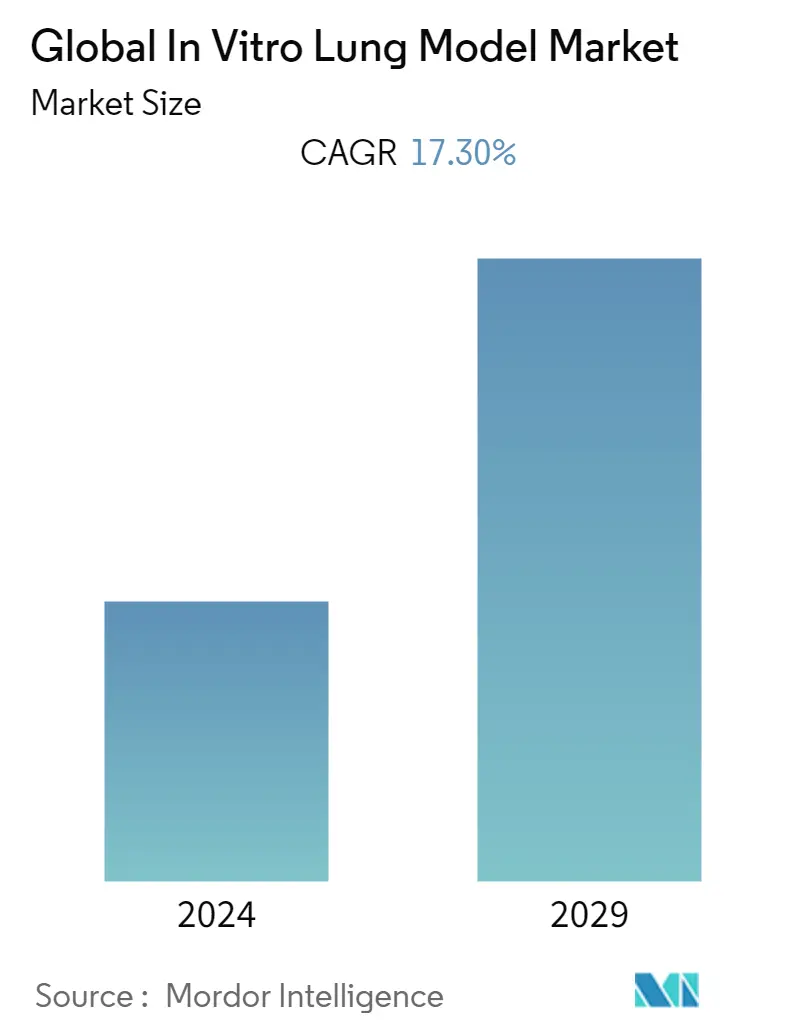Market Size of Global In Vitro Lung Model Industry

| Study Period | 2019 - 2029 |
| Base Year For Estimation | 2023 |
| CAGR | 17.30 % |
| Fastest Growing Market | Asia Pacific |
| Largest Market | North America |
| Market Concentration | Medium |
Major Players
*Disclaimer: Major Players sorted in no particular order |
Need a report that reflects how COVID-19 has impacted this market and its growth?
In-Vitro Lung Model Market Analysis
The In Vitro Lung Model market is expected to register a CAGR of nearly 17.3% during the forecast period.
The COVID-19 virus has spread across the world and its lethality had put scientists and pharmaceutical companies worldwide on the spot to develop novel treatment options and reliable vaccination for billions of people. To combat its associated disease COVID-19 and potentially newly emerging coronaviruses, numerous pre-clinical cell culture techniques were initiated. The COVID-19 pandemic had a significant impact on the in-vitro lung model market. For instance, an article titled, "In Vitro Lung Models and Their Application to Study SARS-CoV-2 Pathogenesis and Disease" published in April 2021 reported that the pandemic had a significant impact on the in-vitro lung model as the spread of SARS-CoV-2 led to the development of in-vitro lung model to study the pathogenesis of this virus. Initially, the growth of this market was hampered by strict lockdowns, as lockdowns led to certain restrictions and scarcity of many goods but with the increase in clinical studies and understanding of the pathophysiology of this virus, the studied market witnessed significant growth.
The factors that are driving this market are the growing focus on developing alternatives for animal testing models technological advancements and the development of new 3D in vitro models. Due to the ethical issues associated with animals, and, despite large similarities, their differences between a given animal species and humans, scientists and researchers have led to the development of an in-vitro model. Also, the increase in the number of pathogens that cause respiratory disease is leading to the development of lung models to understand the pathogenesis of the microbes. For instance, an article titled 'Advanced In Vitro Lung Models for Drug and Toxicity Screening: The Promising Role of Induced Pluripotent Stem Cells' published in December 2021 reported that induced pluripotent stem cells (iPSCs) and organ-on-chip (OOC) technologies possess suitable characteristics for the generation of physiologically relevant in vitro lung models, allowing for developmental studies, disease modeling, and toxicological screening.
Similarly, another article titled, "3D Lung-on-Chip Model Based on Biomimetically Microcurved Culture Membranes" published in May 2022 reported that the complexity of the pulmonary architecture and microenvironment, the inaccessibility of primary lung cells, and the difficulty in maintaining the cellular identity and specific phenotype in vitro have hindered the development of suitable platforms for basic and developmental lung research, disease modeling, and pharmacological screening. All these issues have been overcome by in vitro modeling, which has effectively counteracted the disadvantages of other commonly used cellular sources. Thus, these technological advancements are leading to the development of alternative animal testing models.
The advancements and the development of new 3D in vitro models also have driven the growth of this segment. For instance, an article titled, "Human pluripotent stem cell-derived lung organoids: Potential applications in development and disease modeling" was published in November 2020 and reported that the development of 2D in vitro systems and animal models have been largely employed to elucidate the molecular mechanisms underlying human lung development, physiology, and pathogenesis. More recently, human-derived three-dimensional (3D) models have been generated allowing for a deeper understanding of cell-to-cell communication. The advent of human pluripotent stem cells (hPSCs) and 2D) and three-dimensional (3D) cultures have proven to be reliable models for studying lung development and exploring lung disease pathogenesis and underlying mechanisms.
Thus, due to the aforesaid mentioned reasons, the market is expected to witness significant growth over the forecast period. However, a dearth of skilled professionals may slow down its growth over the forecast period.
